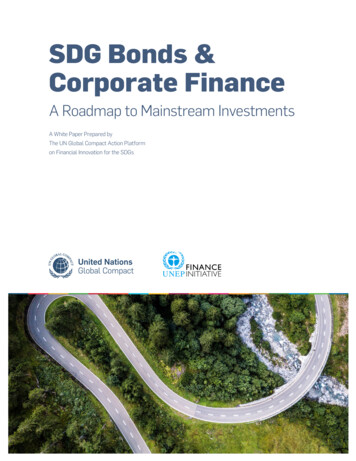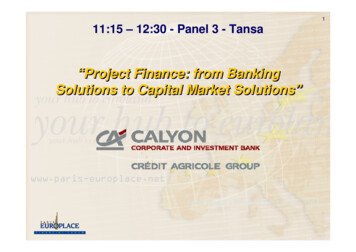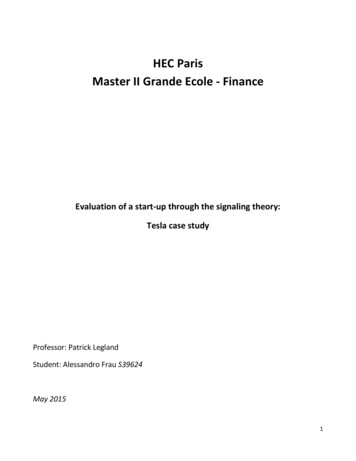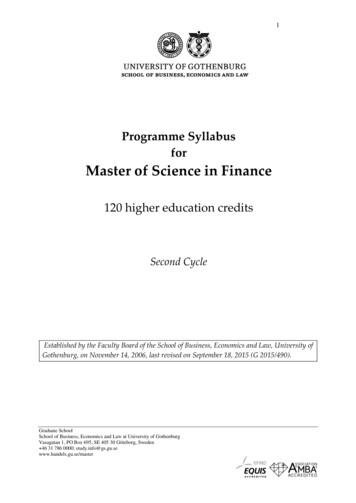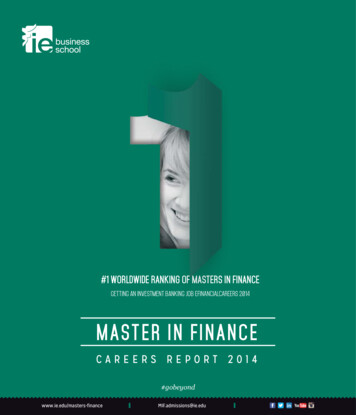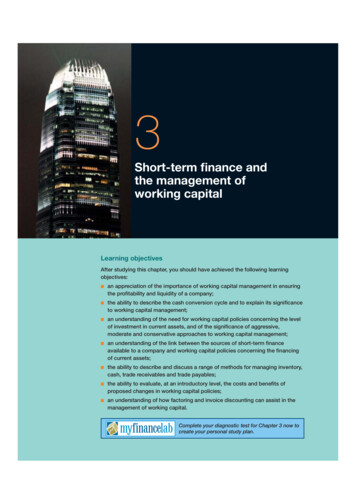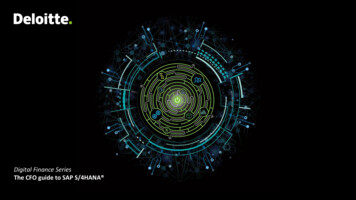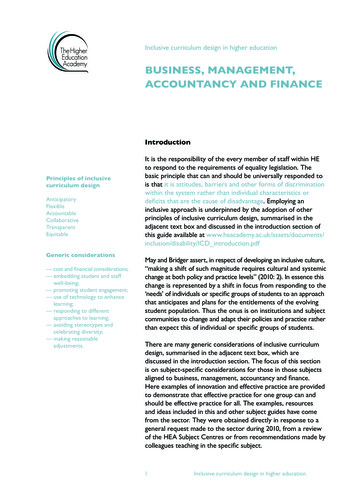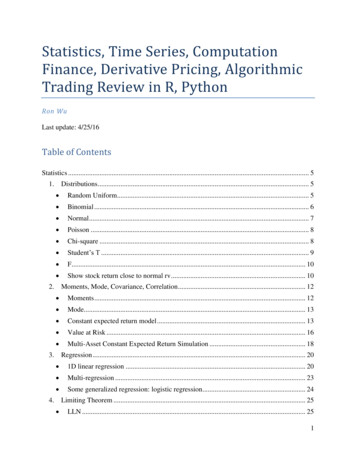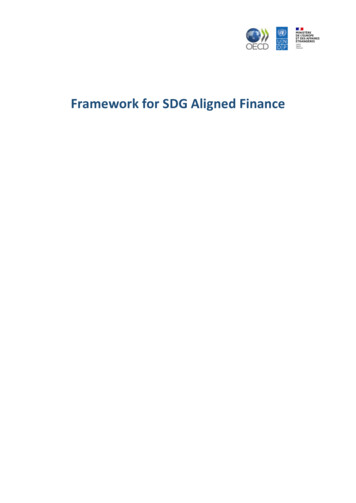
Transcription
Framework for SDG Aligned Finance
OECD - This work is published under the responsibility of the Secretary-General of the OECD. The opinionsexpressed and arguments employed herein do not necessarily reflect the official views of the membercountries of the OECD.UNDP - The findings, analysis, and recommendations of this Framework do not represent the official positionof the UNDP or of any of the UN Member States that are part of its Executive Board. They are also notnecessarily endorsed by those mentioned in the acknowledgments or cited. The mention of specificcompanies does not imply that they are endorsed or recommended by UNDP in preference to others of asimilar nature that are not mentioned. The published material is being distributed without warranty of anykind, either expressed or implied. The responsibility for the interpretation and use of the material lies withthe reader. In no event shall UNDP be liable for damages arising from its use. OECD, UNDP 2020You can copy, download or print OECD content for your own use, and you can include excerpts from OECD publications, databasesand multimedia products in your own documents, presentations, blogs, websites and teaching materials, provided that suitableacknowledgement of OECD as source and copyright owner is given. All requests for public or commercial use and translation rightsshould be submitted to rights@oecd.org. Requests for permission to photocopy portions of this material for public or commercialuse shall be addressed directly to the Copyright Clearance Center (CCC) at info@copyright.com or the Centre français d’exploitationdu droit de copie (CFC) at contact@cfcopies.com.2
INITIATIVE – where has this work come from?At France’s G7 in 2019, Development Ministers commended the OECD and UNDP joint initiative to define acommon framework for aligning finance with the Sustainable Development Goals (SDGs):“Recalling that global private savings amount to trillions of US dollars per year, we stressthe need to catalyse private sector support for the Sustainable Development Goals (SDGs)and to increase transparency on financial flows. In that respect, we commendinternational initiatives conducted by relevant organizations including the Organisationfor Economic Co-operation and Development (OECD) and the United NationsDevelopment Programme (UNDP) aimed at promoting SDG-compatible finance. We takenote of their efforts to take stock of existing initiatives in view of defining a robust commonframework for SDG-compatible finance with all relevant stakeholders, and of theirintention to present their findings from 2020 on in Paris.”1Since this meeting, the OECD and UNDP have been working, with the support of France’s Ministry of ForeignAffairs (MoFA), and an expert group of 80 individuals from across the public and private sector to developa framework, produce a stocktake of initiatives and help identify common challenges, themes, and solutionsto improve SDG alignment of finance. The work has also supported, and benefited from, the UNSG-CanadaJamaica ‘Financing for Development in the Era of COVID-19 and beyond’ consultations, which highlighted thisinitiative and aligning finance to the SDGs as key, stressing the need to use crisis as an opportunity to “alignto the SDGs and Paris Agreement”.2One year on from the G7, this paper sets out the framework’s progress: a critical stocktake of existinginitiatives, and a matrix of identified objectives, recommended actions, building blocks and progressindicators for SDG alignment. The framework is a living document that will be updated on regular basis toreflect progress. In particular, recommendations should be translated into concrete community action plansmatching the priorities and comparative advantages of the different actors and groups of actors along theinvestment chain.The framework focuses on mobilizing and enhancing development impact of private finance throughalignment to the SDGs. To this end, the scope of the framework encompasses private actors (asset managers,pension funds, credit rating agencies, commercial and investment banks, etc.) but also public authorities(governments, central banks, development finance institutions, etc.) - given their role to provide the rightenvironment and set the right incentives to allow the private sector to achieve SDG alignment. As Covid-19demonstrates, the role of governments and public resources are critical to achieving alignment. The publicsector can play a role in shaping market forces, correcting market failures, through providing regulatoryforward guidance and bringing transparency and accountability to end SDG washing, and stepping into themarket directly as investors and providers of public goods. In addition, given the development ministersmandate, the framework gives particular attention to the structural challenges of countries most in need,including LDCs and SIDS.GOAL – what does SDG aligned finance look like?The 2030 Agenda is a plan of action for people, planet and prosperity. It provides, with the SDGs, universalgoals and targets -or a blueprint- to achieve a better and more sustainable future for all. It is supplementedby the Addis Ababa Action Agenda that deals with the means required for the implementation of the SDGs,which include the mobilization of financial resources. It recognizes the role of all actors -public and privatealong the investment chain to implement the Agenda, and the need to better align private sector incentivesand practices with the SDGs to foster long-term quality investment.FRAMEWORK FOR SDG ALIGNED FINANCE OECD, UNDP 20203
SDG alignment is both a means to mobilize resources for the implementation of the 2030 Agenda and a valueproposition for private sector to preserve the long-term value of assets by doing no harm and contributingsolutions to sustainable development challenges, thereby reducing risks and enhancing resilience of theglobal financial system. This double materiality (financial and non-financial) of the SDG alignment agendarelies on the achievement of two objectives:1. Equality: resources should be mobilised to leave no one behind and fill the SDG financing gaps, and2. Sustainability: resources should accelerate progress across the SDGs.With regard to the definition of alignment, the Global Investors for Sustainable Development Alliance (GISD)suggested, “sustainable development investing refers to deploying capital in ways that make a positivecontribution to sustainable development, using the SDGs as a basis for measurement”.3 Yet beyond creatinga net positive impact over the life of the investment, our ambition should also be to aim that investmentdoes no harm across the SDGs.4Recognising that SDG alignment is just a means of enhancing the likely sustainability impact of mobilizedresources, it is the central part of a three-step approach to shifting finance towards the SDGs (see Figure 1)on stages of Mobilisation – Alignment – Impact. SDG alignment allows for the better use of each resource’sleverage power, the reduction of leakages and distortions in resources transmission channels, and theincrease the quality of resources for greater sustainability impact.Figure 1. A three-step approach to shifting finance towards the SDGsNote: Multilateral development bank (MDB) and development finance institutions (DFIs) Source: (OECD, 2018[26]), Global Outlook on Financing forSustainable Development 2019: Time to Face the Challenge, 307995-en.htm.FRAMEWORK FOR SDG ALIGNED FINANCE OECD, UNDP 20204
RATIONALE – why should we care about SDG alignment?As a result of the COVID-19 crisis, the gap to achieving a number of SDGs, including SDG 1 on poverty, isincreasing again. The COVID-19 crisis threatens to set back decades of progress made towardsdevelopment across countries. The 2030 agenda and Paris Agreement, as well as means to respond to thecrisis, are under strain. The crisis magnified the ‘scissors effect’ of SDG financing:1.Declining resources – pre-crisis USD 2.5 trillion that were missing annually to achieve the SDGs by2030 widened with the crisis with an estimated USD 1 trillion gap in COVID-19 emergency andresponse spending in developing countries compared to OECD countries. This, together with anestimated a USD 700 billion loss of external private financing to developing countries, means 2020risks a collapse of development finance. See Figure 2 below.2.Increasing needs – COVID-19 crisis, climate related disasters5, and famine are hitting the mostvulnerable and worsening gender gaps. It is expected that poverty will rise for the first time since1998 with about 100 million people expected to be pushed into extreme poverty and at least twiceas many into poverty, and with hundreds of millions of jobs lost.6 Inequality is rising across manygroups as they are disproportionately affected.7 For example, people from low and middle-incomecountries are seven times more likely to die from natural disasters,8 and the financial burdenassociated with rising debt levels in those climate-vulnerable countries are expected to double overthe next decade. 9Figure 2. COVID-19 will set external private finance back by USD 700 billion, a 60% greater drop thanafter the 2008-09 financial crisisChange of inflows from previous year40Global Financial Crisis (2008)FDIPortfolio invOther inv200USD billion (constant 2019 prices)0% of previous yearRemittancesCOVID-19 (2020)20-20-40-60-80-100-120-140Change of inflows from previous sFDIPortfolio invOther invGlobal Financial Crisis(2008)COVID-19 (2020)Note: All data refer to ODA-eligible countries. The sudden stop of capital flows in 2015 is not shown here, as it would have included a USD 556-billiondrop relating only to China. Other investment excludes IMF lending and Special Drawing Rights allocations.Source: OECD 2020, Global Outlook on Financing for Sustainable development 2021 based on KNOMAD (2020[7]), Remittances inflows . Historical FDI, portfolio investment and other investment data refer to net incurrence of liabilities andare from IMF (2020[8]), Balance of payments (database), http://data.imf.org/bop, and national central bank data. COVID-19 projections are based oncombining historical data with projections on remittances and FDI by the World Bank (2020[25]), “COVID-19 Crisis through a migration /10986/33634, with portfolio and other investment data by the Institute of International Finance(2020[24]), IF Capital Flows Report: Sudden Stop in Emerging Markets, https://www.iif.com/Portals/0/Files/content/2 IIF2020 April CFR.pdf.The COVID-19 crisis provides a stark wakeup call to the importance of aligning our economies to the SDGsand the Paris Agreement for building resilience. The ignorance of systemic risks, poor risk governance andunderinvesting in disaster risk reduction, linked to poor sustainability and equality management acrosscountries, comes at a high price for all: the IMF forecasts a 4.4% decline in global GDP in 2020, with -5.8% inadvanced economies and -3.3% in emerging markets and developing economies. The pandemic has alsoFRAMEWORK FOR SDG ALIGNED FINANCE OECD, UNDP 20205
underlined the interdependence of countries towards achieving public goods and has demonstrated that, asUN Deputy Secretary-General highlights, “no one is safe until we are all safe”10. Finally, it has exposed theinterlinkages between the SDGs such as the links between health, eradication of poverty and continueddegradation of nature. A failure to meet one SDG will be to the detriment of the others and will affect us all.The world is already at a tipping point with nature declining globally at unprecedented rates in humanhistory.11 With more than half of global GDP (55%) depending on high-functioning biodiversity and ecosystemservices (BES)12, failure to adapt and mitigate climate change, extreme weather events, loss of biodiversityand ecosystem collapse, food crises, and water crises will cause irreversible catastrophic damage to peopleand planet. In fact, the OECD estimates that the total annual financial allocation for global biodiversityconservation was between USD 78 and 91 billion per year (2015-17 average)13, a mere fraction of theeconomic impact on the global economy from COVID-19, already estimated in the tens of trillions of dollars.14Hence, the imperative to explore nature-related risks and dependencies to which our economies andfinancial systems are exposed and redirect flows of finance towards nature-positive activities.15Mitigation and reduction of these and other risks is a paramount concern to realise the transformativepotential of the 2030 Agenda and the Paris Agreement. It underlines why SDG alignment is critical. SDGalignment unlocks the resources, directs them towards needs, and builds a more sustainable and inclusiveeconomy, which protects against risks, builds resilience and generates financial returns and economicgrowth. The case for alignment has never been stronger:1. Economic case. Alignment builds resilience and generates economic growth opportunities.Incorporating SDG into business strategies could result in efficiency gains and new economicopportunities worth at least USD 12 trillion by 2030 (more than 10% of global GDP)16 and closing thegender gap in the workforce would add another USD 28 trillion to the global GDP17. Transition to agreen economy could lead to a net increase of approximately 18 million jobs across the world18 andachieving the 2030 Agenda could generate up to 380 million jobs19. Besides, it will reinforcemacroeconomic stability by decreasing systemic risk due to climate change, biodiversity loss or globalpandemics, thus also saving assets and output losses (e.g., business and supply-chain interruptions,production, and tax-revenue loss
Note: All data refer to ODA-eligible countries. The sudden stop of capital flows in 2015 is not shown here, as it would have included a USD 556-billion drop relating only to China. Other investment excludes IMF lending and Special Drawing Rights allocations. Source: OECD 2020, Global Outlook on Financing for Sustainable development 2021 based on KNOMAD (2020[7]), Remittances inflows (database .
